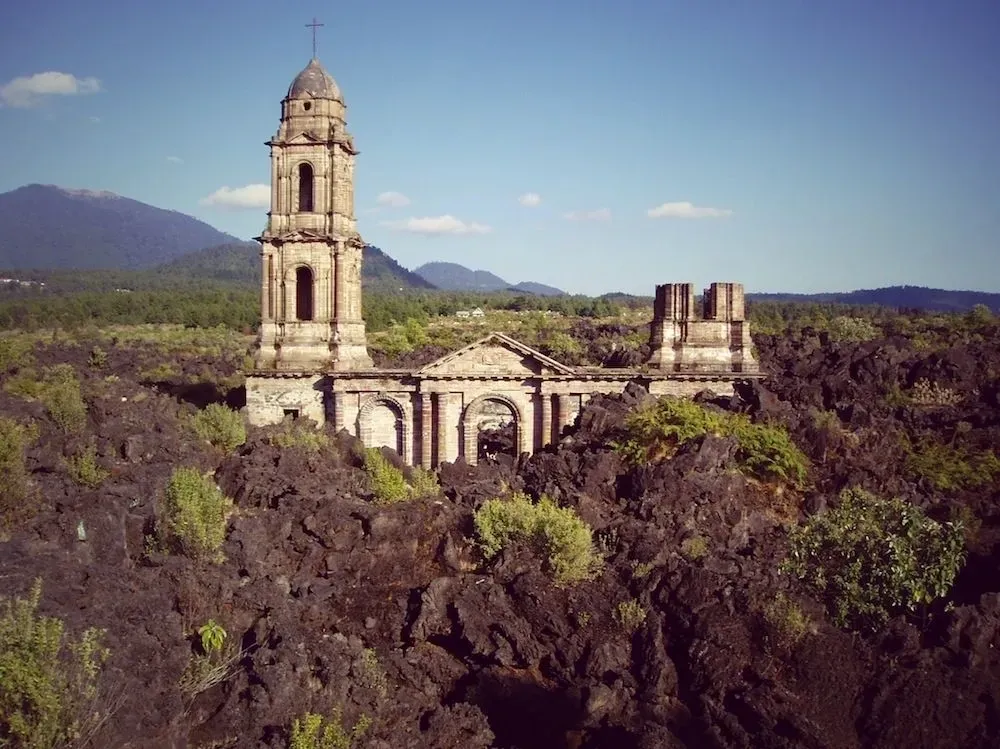Today, the original San Juan Parangaricutiro church still stands, partially buried in solidified lava rock, with the imposing cinder cone of Parícutin looming in the background. It serves as the sole remnant of the village.

The San Juan Parangaricutiro church is a poignant reminder of two villages in Mexico that were obliterated by the Parícutin volcano during the 1940s. Emerging unexpectedly from a cornfield in 1943, the volcano erupted, gradually engulfing the surrounding area in lava and ash over the following eight years. Eventually, the church found itself half-submerged in lava, with only the altar and tower remaining, a testament to the enduring power of nature.


Both the village of Parícutin and San Juan Parangaricutiro were engulfed by layers of ash and lava. Despite this catastrophe, the top portion of the old San Juan Parangaricutiro church still emerges from the volcanic deposits, serving as a poignant reminder of the community’s past.
Nuevo San Juan Parangaricutiro is situated approximately 8 kilometers (5.0 mi) west of Uruapan and 16 kilometers (9.9 mi) east of the peak of Parícutin in central Michoacán. The village bears the postal code 60490.

Marvel at the architectural genius displayed by the Church, showcasing a design that is both unique and rich in symbolic elements. Delve into the fascinating fusion of indigenous and European influences, which come together to create the distinct character of this sacred site.

Discover the rich folklore and traditions intertwined with the Church of San Juan Parangaricutiro, a sacred site steeped in cultural significance.
Local legends abound, weaving tales of resilience and spiritual significance around the church. Stories passed down through generations speak of the church’s endurance in the face of adversity, particularly during the catastrophic eruption of the volcano in 1943. Despite being partially buried under layers of ash and lava, the church emerged as a symbol of hope and resilience, standing tall amidst the desolation.
Religious ceremonies held at the church reflect the deep-rooted faith and spiritual connection of the community. From traditional rituals honoring indigenous beliefs to Christian sacraments, the church serves as a focal point for communal worship and reflection.
The eruption of Parícutin in 1943 marked a defining moment in the history of the region. The reconstruction efforts that followed, including the preservation of the church, stand as a testament to the strength and solidarity of the community. Through collaborative endeavors and unwavering determination, the cultural gem that is the Church of San Juan Parangaricutiro was safeguarded for future generations to cherish and admire.
Parícutin, recognized as one of the seven natural wonders due to its extraordinary birth witnessed by mankind, holds a special place in the hearts of locals and visitors alike. Despite its dormant state since the last eruption in 1952, the volcano’s towering presence continues to serve as a reminder of the awe-inspiring forces of nature. Its rapid growth, reaching three-fourths of its size within the first year of eruption, remains a testament to the remarkable and ever-evolving landscape of the region.

May we continue to cherish and honor this sacred place, recognizing its role not only as a place of worship but also as a symbol of cultural identity and historical legacy. As we bid farewell to our exploration, let us carry with us the profound lessons and timeless beauty encapsulated within the walls of this cherished landmark.

